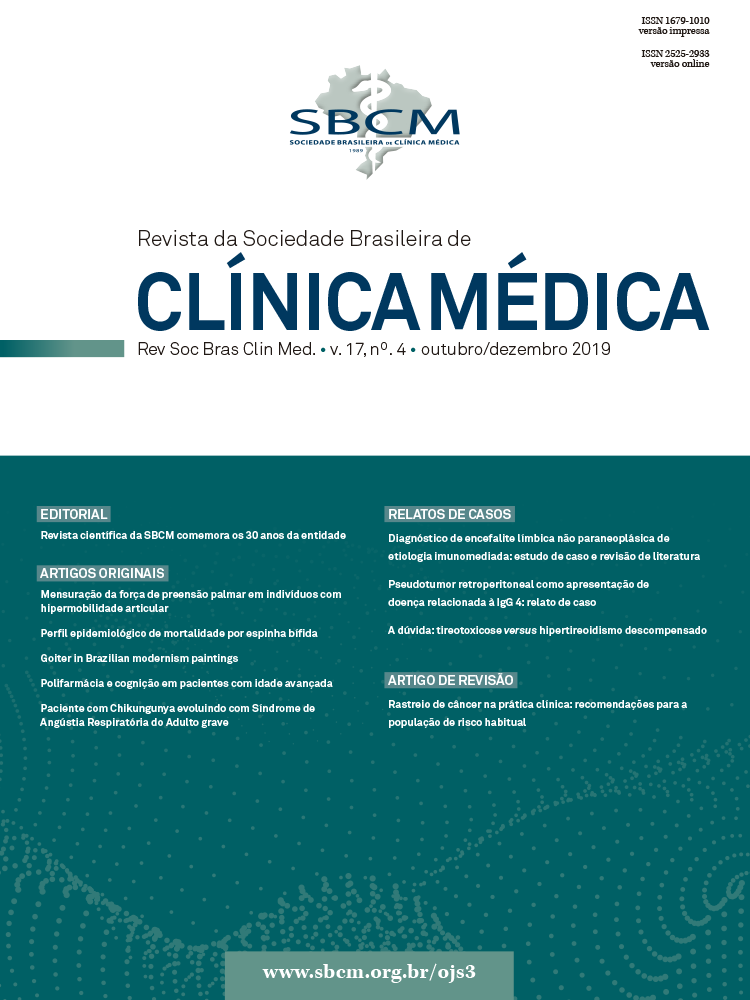Goiter in Brazilian modernism paintings
Main Article Content
Resumo
Objective: To evaluate Di Cavalcanti’s artworks in which goiters are represented before and after the introduction of iodized salt to the Brazilian population. Methods: One hundred and thirty paintings by Di Cavalcanti from the 20’s to 70’s demonstrating necks were evaluated. All the paintings were observed in reproductions. The neck circumference in the paintings was measured. Since there were no standard thresholds of neck circumference, cutoffs were based on the median. Baseline characteristics of artworks were compared based on high and normal neck circumference categories using Student’s t-test, Mann-Whitney-Wilcoxon test, or chi square test. Results: We analyzed 29 artworks which portray the neck of 60 women (84.5%), 8 men (11.3%) and 3 children (4.2%). The analyses of the neck circumference showed 23.3% of women (14/60), 12.5% of men (1/8), and 33.3% of children (1/3) with an abnormal profile of the neck circumference. The neck circumference ratio in 29 paintings showed that the relative sizes of the necks painted between the 1920’s and 1950’s (r=0.45; p=0.03), and painted between the 1960’s and 70’s (r= 0.54; p=0.003) have linearly decreased. The decades in which the artworks were painted explained 40.0% of the variation in size of the neck circumference (p=0.002). Conclusion: Art imitates life. Di Cavalcanti was not a physician, and probably did not have the intention to illustrate a pathological condition, although the images observed in this study should be considered as goiter or enlarged neck.
Article Details
Declaração de Direito Autoral
Eu (nome do autor responsável) _______________________________________________ declaro que o presente artigo intitulado ___________________________________é original, não tendo sido submetido à publicação em qualquer outro periódico nacional ou internacional, quer seja em parte ou em sua totalidade. Declaro, ainda, que uma vez publicado na revista Revista da Sociedade Brasileira de Clinica Médica, editada pela Sociedade Brasileira de Clínica Médica, o mesmo jamais será submetido por um dos demais co-autores a qualquer outro meio de divulgação científica impressa ou eletrônica.
Por meio deste instrumento, em meu nome e dos demais co-autores, cedo os direitos autorais do referido artigo à Revista da Sociedade Brasileira de Clinica Médica, e declaro estar ciente de que a não observância deste compromisso submeterá o infrator a sanções e penas previstas na Lei de Proteção de Direitos Autorias (n 9610 19 de fevereiro de 1998) que altera, atualiza e consolida a legislação sobre direitos autorais e dá outras providências. Disponível em: http://www.planalto.gov.br/ccivil_03/leis/l9610.htm
|
_________________________ |
___________________ |
|
Local, data |
Assinatura |
SOCIEDADE BRASILEIRA DE CLÍNICA MÉDICA
CNPJ/MF 062.279.617/0001-45
Rua Botucatu, nº 572, cj. 112, São Paulo, SP
Download da Declaração de Direito Autoral.
